#Tool Orientation Key
Explore tagged Tumblr posts
Text
Fadal Tool Changer Parts - Complete Guide
About Fadal Tool Changer Parts In the world of CNC machining, the efficiency of a Fadal Tool Changer is paramount. To ensure seamless operations, ITSCNC presents a comprehensive range of new and re-manufactured replacement parts for Fadal Tool Changer, meticulously crafted to meet original factory specifications. Elevating the standard for precision and reliability, these parts are backed by a…

View On WordPress
#Arm Roller Assembly#BT Tool Clip#Bucket Assembly#CAT40 Tool Clip#Dual Arm Tool Changer#Fadal Arbor Shim#Fadal cnc parts#Fadal CNC Replacement Parts#fadal machine parts#Fadal parts#Fadal Parts For CNC Machine#fadal parts online#Roller Bearing#Servo Turret Amplifier#Tool Orientation Key#turret carrier 21 position cat with 42 roll pins#Turret Spindle#Turret Worm Gear
1 note
·
View note
Text

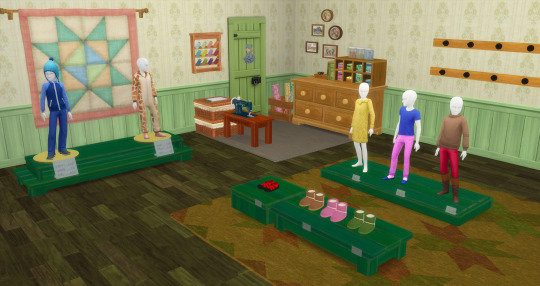
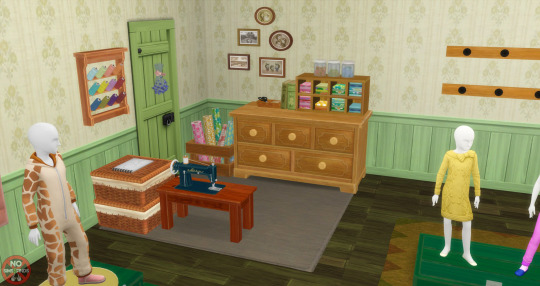
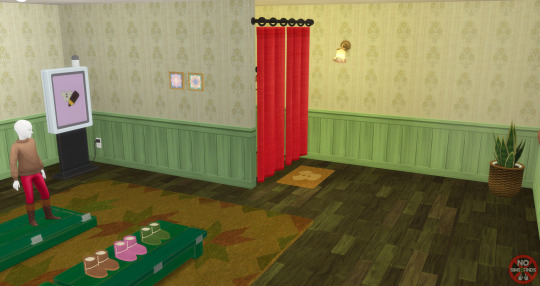
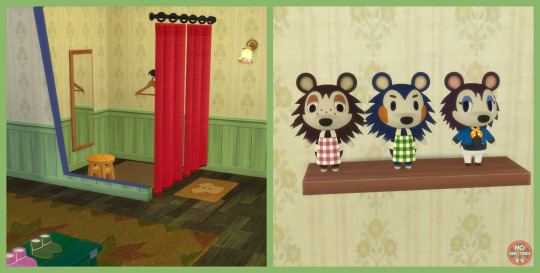


🧵 ACNH Able Sisters Store Set 🪡
Sims 4, Base game compatible | 48 Now 51 items
(added the awning, chimney, and the stairs as a deco item with no footprint)
All the items you'll need to recreate The Able Sisters cute little shop in your TS4 game. All items came with only 1 swatch each. There are a few items that I added a couple of extra swatches for.
As always, turning the brightness down on functional lamps will make them look better (not overly bright) due to my vertex paint issue in Blender.
Type “ACNH Able” into the search query in build mode to find quickly. You can always find items like this, just begin typing the title and it will appear.
Use the raise & lower keyboard cheat to put your already styled mannequins onto the displays. The displays have slots, but mannequins will only let you place them on the floor, and won't allow styling once they have been raised, so make sure to do that first. They only need to be raised 1-2 notches depending on which display you are placing them on.
Use the scale up & down feature on your keyboard to make the items larger or smaller to your liking. If you have a non-US keyboard, it may be different keys depending on which alphabet it uses.
I hope you enjoy! ☺️
Set contains: Buy: -Books Decor | 1 swatch | 70 poly -Display Tables 1-4 (for mannequins, slotted but see note above for using mannequins on tables) | 1 swatch each | 126, 594, 250, & 148 poly -Dresser Table (functional dresser) | 4 swatches | 796 poly -Fabric Crate | 3 swatches | 1156 poly -Fabric Cubby (slotted) | 1 swatch | 644 poly -Fitting Room Curtain | 1 swatch | 3482 poly -Framed Quilt (storefront) | 3 swatches | 44 poly -Framed Quilting (2 framed squares) | 1 swatch | 86 poly -Framed Wall Photos | 1 swatch | 376 poly -Hanging Flowers | 1 swatch | 778 poly -Hanging Quilt | 1 swatch | 590 poly -Jars | 1 swatch | 1815 poly -Label Doll | 4 swatches for facial expression | 6956 poly -Lamp: Indoor | 1 swatch | 740 poly -Lamp: Outdoor | 2 swatches | 282 poly -Large Baskets (slotted) | 3 swatches | 822 poly -Mabel Doll | 4 swatches for facial expression | 6200 poly -Pencil | 1 swatch | 70 poly -Potted Plant | 2 swatches | 776 poly -Rug: Fitting Room 1 | 1 swatch | 10 poly -Rug: Fitting Room 2 | 1 swatch | 34 poly -Rug: Large | 1 swatch | 587 poly -Rug: Sewing | 1 swatch | 108 poly -Sable Doll | 4 swatches for facial expression | 6200 poly -Sewing Machine | 1 swatch | 1976 poly -Sewing Table | 1 swatch | 224 poly -Sketchbook (slotted for pencil or whatever!) | 1 swatch | 542 poly -Stool End Table (Dressing Room) | 3 swatches | 298 poly -Store Sign (storefront) 6 different items for different languages (English, French, German, Italian, NL, Spanish) | 1 swatch each | 1194 poly -Store Sign 2 (hanging) | 2 swatches | 174 poly -Store Window Display | 1 swatch | 820 poly -Tailoring Machine 1-2 (screen glows in the dark) | 1 swatch each | 462 & 736 poly -Tool Basket | 1 swatch | 721 poly -Wall Hanger (dressing room) | 2 swatches | 324 poly -Wall Hooks Panel | 1 swatch | 380 poly -Wall Mirror | 1 swatch | 44 poly -Wall Spools | 1 swatch | 894 poly
Build: -Wallpaper/Paneling | 1 swatch -Wood Floor | 2 swatches for orientation
📁 Download all or pick & choose (SFS, No Ads): HERE
📁 Alt Mega Download (still no ads): HERE
📁 Download on Patreon
Will be public on December 5th, 2023
Happy Simming! ✨ Some of my sets will be early access from now on. If you like my work, please consider supporting me:
★ Patreon 🎉 ❤️ |★ Ko-Fi ☕️ ❤️ ★ Instagram📷
Thank you for reblogging ❤️ ❤️ ❤️
@sssvitlanz @maxismatchccworld @mmoutfitters @coffee-cc-finds @itsjessicaccfinds @gamommypeach @stargazer-sims-finds @khelga68 @suricringe @vaporwavesims @mystictrance15 @public-ccfinds
The rest of my CC
#s4cc#ts4cc#ts4mmcc#sims 4 sewing#sims 4 retail#sims 4 acnh location#sims 4 tailor#sims 4 furniture#sims 4 table#sims 4 dresser#sims 4 mirror#sims 4 wall decor#sims 4 wall object#sims 4 flowers#sims 4 jars#sims 4 jar#sims 4 rug#sims 4 rugs#sims 4 curtain#sims 4 display#sims 4 plant#sims 4 flower pot#sims 4 sign#sims 4 retail sign#able sisters#sims 4 framed photos#sims 4 painting#sims 4 quilt#sims 4 tapestry#sims 4 toy
902 notes
·
View notes
Text
Chaos Magick
Chaos Magick is a modern form of occultism that defies traditional structures and dogmas, embracing a pragmatic, results-oriented approach to magical practice. Unlike conventional magical systems that adhere to specific rituals, symbols, and deities, Chaos Magick emphasizes flexibility, personal belief, and the use of any technique or symbolism that achieves the desired outcome. Originating in the late 20th century, Chaos Magick has become a significant and influential movement within the broader landscape of contemporary occultism, attracting practitioners who value creativity, experimentation, and personal empowerment. This essay explores the history, principles, practices, and significance of Chaos Magick.
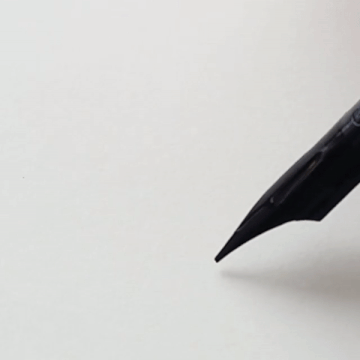
History of Chaos Magick
Chaos Magick emerged in the late 1970s and early 1980s as a response to the rigid structures of traditional ceremonial magick and the occult revival movements of the 19th and 20th centuries. The origins of Chaos Magick can be traced to the writings of occultists such as Peter J. Carroll and Ray Sherwin, who were instrumental in developing and popularizing this new approach to magic.
The Influence of Austin Osman Spare:
A significant precursor to Chaos Magick was the work of artist and occultist Austin Osman Spare (1886-1956). Spare's ideas about the subconscious mind, sigils, and the power of belief were highly influential on later Chaos Magicians. He emphasized the use of personal symbols and the manipulation of belief as tools for magical success, laying the groundwork for many of the ideas central to Chaos Magick.
The Birth of the Movement:
In the late 1970s, Peter J. Carroll and Ray Sherwin co-founded the Illuminates of Thanateros (IOT), a magical order dedicated to the practice and development of Chaos Magick. Carroll’s seminal works, "Liber Null" (1978) and "Psychonaut" (1982), became foundational texts for Chaos Magicians. These books outlined the core principles of Chaos Magick, including the emphasis on belief as a tool, the use of sigils, and the concept of "paradigm shifting," where practitioners adopt different belief systems as needed.
Spread and Evolution:
Throughout the 1980s and 1990s, Chaos Magick grew in popularity, particularly in the United Kingdom and the United States. The movement attracted individuals interested in a more personalized and experimental approach to magic, free from the dogmatic constraints of traditional systems. As Chaos Magick evolved, it incorporated influences from psychology, science fiction, pop culture, and postmodern philosophy, reflecting its eclectic and adaptive nature.
Principles of Chaos Magick
Chaos Magick is characterized by several key principles that distinguish it from other forms of magical practice. These principles emphasize flexibility, pragmatism, and the central role of belief in achieving magical outcomes.
Belief as a Tool:
One of the core tenets of Chaos Magick is the idea that belief itself is a powerful tool in magic. Unlike traditional magical systems that require adherence to specific beliefs or deities, Chaos Magick posits that the act of believing—regardless of what is believed—is what makes magic effective. Practitioners are encouraged to adopt and discard beliefs as needed to achieve their desired results, treating belief as a flexible and dynamic tool rather than a fixed truth.
Paradigm Shifting:
Closely related to the use of belief as a tool is the concept of "paradigm shifting." In Chaos Magick, a paradigm is a framework of beliefs, symbols, and practices that a magician temporarily adopts to work a particular spell or ritual. A Chaos Magician might shift between different paradigms—such as using Kabbalistic symbols in one ritual and invoking Lovecraftian deities in another—depending on what they find most effective for their goals. This fluid approach allows practitioners to draw from a wide range of magical and cultural traditions.
Pragmatism and Results-Oriented Practice:
Chaos Magick is inherently pragmatic, focusing on what works rather than adhering to tradition or doctrine. The effectiveness of a magical practice is judged solely by the results it produces. This results-oriented approach encourages experimentation and the development of new techniques, as well as the modification or abandonment of practices that do not yield desired outcomes.
Use of Sigils:
Sigilization, a technique popularized by Austin Osman Spare, is a central practice in Chaos Magick. A sigil is a symbol created by condensing a specific intention or desire into a visual form. The practitioner then uses various methods to "charge" the sigil with energy and launch it into the subconscious mind, where it works to manifest the desired outcome. Sigils are valued for their simplicity and adaptability, making them a popular tool among Chaos Magicians.
The Gnostic State:
Achieving a state of altered consciousness, often referred to as the "Gnostic State" or "gnosis," is a key component of Chaos Magick rituals. This state of mind, in which the practitioner is highly focused and free from distractions, is believed to be crucial for the successful performance of magic. Various methods, such as meditation, chanting, visualization, or sensory deprivation, are used to induce gnosis.
Practices of Chaos Magick
Chaos Magick is known for its eclectic and innovative practices, which can vary widely from one practitioner to another. The following are some of the most common practices associated with Chaos Magick:
Sigil Magic:
As mentioned, sigil magic is a cornerstone of Chaos Magick. The process typically involves creating a sigil by writing out a statement of intent, removing duplicate letters, and arranging the remaining letters into an abstract symbol. The practitioner then enters a Gnostic State, charges the sigil with intent, and either destroys or forgets the sigil to allow it to work subconsciously.
Magical Experimentation:
Chaos Magicians often experiment with a variety of techniques, drawing from different magical traditions, religions, and even pop culture. This might include invoking gods from different pantheons, working with fictional characters as if they were real entities, or incorporating elements of modern technology into rituals. The emphasis is always on what is effective for the individual practitioner.
Deconstructing and Reconstructing Beliefs:
Chaos Magicians regularly engage in the practice of deconstructing and reconstructing their beliefs. By deliberately adopting different belief systems, even those they do not inherently believe in, they explore the effects of belief on reality. This practice often leads to a deeper understanding of the fluid nature of reality and the power of the mind in shaping experience.
Use of Pop Culture and Modern Symbols:
One of the more unique aspects of Chaos Magick is its embrace of contemporary symbols and icons from pop culture. Practitioners might use characters from movies, comic books, or video games as symbols in their rituals, treating these figures as modern-day deities or archetypes. This reflects Chaos Magick's adaptability and its focus on personal relevance over tradition.
Psychological Techniques:
Many Chaos Magicians incorporate psychological techniques into their practice, drawing from fields such as cognitive psychology, NLP (Neuro-Linguistic Programming), and hypnosis. These techniques are used to alter consciousness, influence perception, and reinforce the practitioner’s intent. The integration of psychological methods underscores Chaos Magick's pragmatic and results-driven approach.
Significance and Influence of Chaos Magick
Chaos Magick has had a profound impact on modern occultism, influencing both magical practice and the broader cultural understanding of magic. Its emphasis on flexibility, innovation, and personal empowerment has resonated with a new generation of practitioners who seek a more individualized and adaptive approach to magic.
Democratization of Magic:
One of the most significant contributions of Chaos Magick is the democratization of magical practice. By rejecting rigid hierarchies, dogmas, and the need for formal initiation, Chaos Magick has made occult practices more accessible to a wider audience. Anyone can become a Chaos Magician, regardless of background or experience, as long as they are willing to experiment and learn.
Cultural Impact:
Chaos Magick has also influenced popular culture, particularly in areas related to the occult, science fiction, and the countercultural movements of the late 20th and early 21st centuries. Concepts from Chaos Magick, such as paradigm shifting and the use of pop culture symbols, have found their way into literature, movies, and art, reflecting the movement's broad cultural reach.
Challenges to Traditional Magic:
Chaos Magick challenges the conventional understanding of magic by questioning the necessity of belief in any particular system or deity. This has led to debates within the occult community about the nature of magic, the role of belief, and the effectiveness of traditional practices. Chaos Magick's focus on results over tradition has encouraged many practitioners to rethink their approach to magic.
Influence on Postmodern Thought:
Chaos Magick is often associated with postmodernism, particularly its skepticism of grand narratives and its emphasis on individual experience. The movement’s fluid approach to reality, belief, and identity aligns with postmodern ideas about the constructed nature of reality and the multiplicity of truths. This has made Chaos Magick particularly appealing to those who resonate with postmodern philosophy.
Conclusion
Chaos Magick represents a radical departure from traditional magical systems, offering a flexible, pragmatic, and highly individualized approach to occult practice. By emphasizing the power of belief, the importance of personal experience, and the value of experimentation, Chaos Magick has redefined what it means to practice magic in the modern world. Its influence extends beyond the occult community, challenging cultural and philosophical assumptions about reality, belief, and the nature of power. As a living, evolving tradition, Chaos Magick continues to inspire and empower those who seek to explore the mysteries of existence on their own terms.

#mysticism#occultism#metaphysics#mystic#magick#chaos magick#sigil magick#witchcraft#witchblr#witch#wicca#grimoire#chatgpt
182 notes
·
View notes
Text
Unlocking the Power of Dialogue Tags in Fictional Writing
In the realm of fictional writing, dialogue is not just about what characters say; it's also about how they say it. This is where dialogue tags come into play. Often overlooked, these small phrases can dramatically transform your storytelling, offering readers insights into your characters' emotions, intentions, and personalities. Let's delve into the art of using dialogue tags effectively in fictional writing.
What are Dialogue Tags?
Dialogue tags are brief phrases that accompany dialogue, identifying the speaker and often describing how something is said. Classic examples include 'said', 'asked', and 'replied'. However, the world of dialogue tags is vast and varied, allowing writers to add depth and color to their conversations.
The Importance of Variety
While 'said' is a workhorse in dialogue tags, being unobtrusive and easily overlooked, overusing it can render your writing monotonous. Introducing variety is key. Consider using tags like 'whispered', 'shouted', 'murmured', or 'exclaimed' to convey emotions and volume. But beware, overuse of overly descriptive tags can distract the reader. The trick is to strike a balance.
Conveying Action and Emotion
Dialogue tags can do much more than identify who is speaking. They can also convey action and emotion. For instance, 'she said, slamming the door' instantly tells the reader about the character's emotional state. Using action-oriented dialogue tags can also help in reducing the adverb usage, which often clutters writing.
The Subtlety of Beats
Sometimes, it's effective to replace dialogue tags with action beats. Action beats are small actions or descriptions that interrupt dialogue. For example:
"Are you okay?" John leaned forward, concern etching his face.
Here, 'John leaned forward' acts as a beat, breaking up the dialogue and adding a layer of description.
Avoiding Common Pitfalls
One common pitfall in using dialogue tags is redundancy. Saying 'she yelled loudly' can be tautological since yelling is inherently loud. Additionally, avoid overly creative dialogue tags that can confuse the reader. Stick to simplicity where it adds value.
Using Dialogue Tags for Pacing
Dialogue tags can also control the pacing of your narrative. A quick back-and-forth conversation with minimal tags can speed up the pace, making the scene feel urgent or intense. Conversely, adding descriptive tags and beats can slow down the dialogue, allowing for deeper emotional impact.
Conclusion
In conclusion, dialogue tags are a powerful tool in a writer's arsenal. They provide clarity, convey emotions, and enhance the rhythm of your narrative. By mastering their use, you can elevate your fictional writing, creating stories that resonate deeply with your readers. Remember, in the dance of dialogue, tags are your rhythm - use them to make your story sing.
Don’t forget our Grand Opening Giveaway starts February 1st/24 on Tumblr, Instagram and slayingfiction.com! You don’t want to miss it!
Happy Writing!
#novel writing#tumblr writers#writing advice#writing#writeblr#creative writing#fiction#writer#writing community#dialogue#writing dialogue#dialogue tag
537 notes
·
View notes
Text
You can’t shop your way out of a monopoly
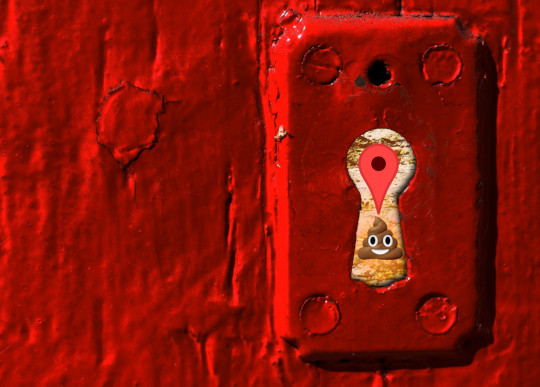
I'm on tour with my new, nationally bestselling novel The Bezzle! Catch me in TUCSON (Mar 9-10), then SAN FRANCISCO (Mar 13), Anaheim, and more!

If you're running a business, you can either invest at being good at your business, or good at Google SEO. Choose the former and your customers will love you – but they won't be able to find you, thanks to the people who choose the latter. And if you're going to invest in top-notch SEO, why bother investing in quality at all?
For more than a decade, Google has promised that it would do something about "lead gens" – services that spoof Google into thinking that they are local businesses, pushing down legit firms on both regular search and Google Maps (these downranked businesses invested in quality, not SEO, remember). Search for a roofer, a plumber, an electrician, or a locksmith (especially a locksmith), and most or all of the results will be lead-gens. They'll take your call, pretend to be a local business, and then call up some half-qualified bozo to come out and charge you four times the going rate for substandard work:
https://www.nytimes.com/2016/01/31/business/fake-online-locksmiths-may-be-out-to-pick-your-pocket-too.html
Some of them just take your money and they "go back to the shop for a tool" and never return:
https://www.riverfronttimes.com/news/when-a-fake-business-used-a-real-st-louis-address-things-got-weird-32087998
Google has been promising to fix this since the late aughts, and to be fair, it's a little better. There was once a time when a map of Manhattan showed more locksmiths than taxis:
https://blumenthals.com/blog/2009/02/18/google-maps-proves-more-locksmiths-in-nyc-than-cabs/
But GMaps is trapped in the enshittification squeeze. On the one hand, the company wants to provide a good and reliable map. On the other hand, the company makes money selling "ads" that are actually payola, where a business can pay to get to the top of the listings or get displayed on the map itself. Zoom out of Google's map of central London and the highlighted landmarks are a hilarious mix of "organic" and paid listings: the British Museum, Buckingham Palace, the Barbican, the London Eye…and a random oral and maxillofacial clinic in the financial district:
https://twitter.com/dylanbeattie/status/1764711667663831455
Hell of a job "organizing the world's information and making it universally accessible and useful," Big G. Doubtless the average Londoner finds the presence of this clinic super helpful in orienting themselves relative to the map on their phone screens, and it's a real service to tourists hoping to hit all the major landmarks.
It's not just Maps users who'd noticed the rampant enshittification. Even the original design team is so horrified they're moved to speak out about the moral injury they experience seeing the product they worked so hard on turned into a giant pile of shit:
https://twitter.com/elizlaraki/status/1727351922254852182
Now, when it comes to locksmiths, I'm lucky. My neighborhood in Burbank includes the wonderful Golden State Lock and Safe, which has been in business since 1942:
https://www.goldenstatelock.com/
But you wouldn't know it from searching GMaps for a locksmith near me. That search turns up a long list of scams:
https://www.google.com/maps/search/locksmith/@34.1750451,-118.369948,14z/data=!3m1!4b1?entry=ttu
It also turns up plenty of Keyme machines – these are private-equity backed, self-serve key-cutting machines placed in grocery stores. Despite Keyme calling itself a "locksmith," it's just a badly secured, overcaptilized, enshittification-bound system for collecting and retaining shapefiles for the keys to millions of homes, cross-referenced with billing information that will make it easy for the eventual hackers to mass-produce keys for all those poor suckers' houses.
(Hilariously, Keyme claims to be an "AI" company):
https://www.businesswire.com/news/home/20200114005194/en/KeyMe-Raises-35-Million-to-Further-Its-Mission-of-Building-the-Premier-Locksmith-Services-Company-in-the-Nation
But despite the fact that you can literally see the Golden State storefront from Google Streetview, Google Maps claims to have no knowledge of it. Instead, Streetview labels Golden State "Keyme" – and displays a preview showing a locksmith using a tool to break into a jeep (I'd dearly love to know how the gadget next to the Slurpee machine at the 7-Eleven will drive itself to your jeep and unlock the door for you when you lose your keys):
https://www.google.com/maps/place/KeyMe+Locksmiths/@34.1752624,-118.3487531,3a,75y,350.19h,90.21t/data=!3m6!1e1!3m4!1ssHrtqjqvgFir3NBauMy13Q!2e0!7i16384!8i8192!4m15!1m8!3m7!1s0x80c2959cd65dbb1b:0x4b3744cf87492a71!2sBurbank+Blvd+%26+N+Hollywood+Way,+Burbank,+CA+91505!3b1!8m2!3d34.1750025!4d-118.3493484!16s%2Fg%2F11f37_3lq8!3m5!1s0x80c2951cedbf4d39:0xe8ff9fd5872e66e9!8m2!3d34.1755176!4d-118.349!16s%2Fg%2F11mw7nr4fx?entry=ttu
It's pretty clear to me what's going on here. Keyme has hired some SEO creeps and/or paid off Google, flooding the zone with listings for its machines. Meanwhile, Golden State, being merely good at locksmithing, has lost the SEO wars. Perhaps Golden State could shift some of its emphasis from being good at locksmithing in order to get better at SEO, but this is a race that will always be won by the firm that puts the most into SEO, which will always be the firm that puts the least into quality.
Whenever I write about this stuff, people inevitably ask me which search engine they should use, if not Google?
And there's the rub.
Google used predatory pricing and anticompetitive mergers to acquire a 90% search market-share. The company spends more than $26b/year buying default position in every place where you might possibly encounter a new search engine. This created the "kill zone" – the VC's term of art for businesses that no one will invest in, because Google makes sure that no one will ever find out it exists:
https://www.theverge.com/23802382/search-engine-google-neeva-android
That's why the only serious competitor to Google is Bing, another Big Tech company (Bing is also the primary source of results on Duckduckgo, which is why DDG sometimes makes exceptions for Microsoft's privacy-invading tracking):
https://en.wikipedia.org/wiki/DuckDuckGo#Controversies
Google tells us that the quid-pro-quo of search monopolization is search excellence. The hundreds of billions it makes every year through monopoly control gives it the resources it needs to fight spammers and maintain search result quality. Anyone who's paid attention recently knows that this is bullshit: Google search quality is in free-fall, across all its products:
https://downloads.webis.de/publications/papers/bevendorff_2024a.pdf
But Google doesn't seem to think it has a problem. Rather than devoting all its available resources to fighting botshit, spam and scams, the company set $80 billion dollars alight last year with a stock buyback that was swiftly followed with 12,000 layoffs, followed by multiple subsequent rounds of layoffs:
https://pluralistic.net/2024/02/21/im-feeling-unlucky/#not-up-to-the-task
The scams that slip through Google's cracks are sometimes nefarious, but just as often they're decidedly amateurish, the kind of thing that Google could fix by throwing money at the problem, say, to validate that new ads for confirmed Google merchants come from the merchant's registered email addresses and go to the merchant's registered website:
https://pluralistic.net/2023/02/24/passive-income/#swiss-cheese-security
Search is a capital intensive business, and there are real returns to scale, as the UK Competition and Market Authority's excellent 2020 study describes:
https://assets.publishing.service.gov.uk/media/5fe4957c8fa8f56aeff87c12/Appendix_I_-_search_quality_v.3_WEB_.pdf
But Google doesn't seem to think that its search needs that $80 billion to fight the spamwars. That's the thing about monopolists, they get complacent. As Lily Tomlin's "Ernestine the AT&T operator" used to say, "We don't care, we don't have to, we're the phone company."
That's why I'm so excited about the DOJ Antitrust Division monopolization case against Google. Trusting one company to "organize the world's information and make it universally accessible and useful," was a failure:
https://www.justice.gov/opa/pr/justice-department-sues-google-monopolizing-digital-advertising-technologies
I understand why people want to know which search engine they should use instead of Google, and I get why, "There aren't any good search engines" is such an unsatisfactory answer. I understand why each fresh round of printer-company fuckery prompts people to ask "which printer should I get?" and I understand why "There are only six major printer companies and they're all suffering from end-stage enshittification" isn't what anyone wants to hear.
We want to be able to vote with our wallets, because it's so much faster and more convenient than voting with our ballots. But the vote-with-your-wallet election is rigged for the people with the thickest wallets. Try as hard as you'd like, you just can't shop your way out of a monopoly – that's like trying to recycle your way out of the climate emergency. Systemic problems need systemic solutions – not individual ones.
That's why the new antitrust matters so much. The answer to monopolies is to break up companies, block and unwind mergers, ban deceptive and unfair conduct. "Caveat emptor" is the scammer's motto. You shouldn't have to be an expert on lead gen scams to hire a locksmith without getting ripped off.
There are good products and services out there. Earlier this year, we decided to install a (non-networked) programmable pushbutton lock. I asked Deviant Ollam – whom I know from Defcon's Lockpicking Village – for a recommendation and he suggested the Schlage FE595:
https://www.schlage.com/en/home/products/FE595PLYFFFFLA.html
I liked it so much I bought another one for my office door. Eric from Golden State Lock and Safe installed it while I wrote this blog-post. It's great. I recommend both of 'em – 10/10, would do business again.

Name your price for 18 of my DRM-free ebooks and support the Electronic Frontier Foundation with the Humble Cory Doctorow Bundle.

If you'd like an essay-formatted version of this post to read or share, here's a link to it on pluralistic.net, my surveillance-free, ad-free, tracker-free blog:
https://pluralistic.net/2024/03/05/the-map-is-not-the-territory/#vapor-locksmith

Image: alicia rae (modified) https://commons.wikimedia.org/wiki/File:Kehole_Red.jpg
CC BY 2.0 https://creativecommons.org/licenses/by-sa/2.0/deed.en
--
Budhiargomiko (modified) https://commons.wikimedia.org/wiki/File:Wasteland.jpg
CC BY-SA 4.0 https://creativecommons.org/licenses/by-sa/4.0/deed.en
244 notes
·
View notes
Note
hi! i was wondering if you could share the overlay and/or explain how you made the first gif in the last set you posted? thank you very much in advance <3
Hi anon! I'd be happy to share how I created the ripped paper effect in this gifset !

You’ll need a basic knowledge of gifmaking and photoshop, and I’ll put the rest of this under the cut.
1) Creating your gifs
So to start off you're going to create your gifs in separate canvases. I work in timeline mode and I add my sharpening and colouring, and I put both gifs in groups (explained here).
Here are my gifs on separate canvases. For reference, I've called the one on the left "grocery store" and the one on the right "parents".

You'll then want to copy and paste your gif groups onto the same canvas. This is what my canvas and layers panel looks like once that's done. From here, you're ready to start the ripped paper effect.
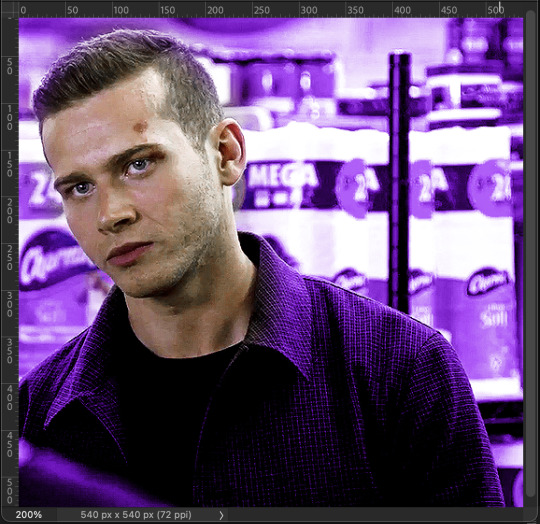

2) Ripped paper overlay
For this step, you want to obtain your ripped paper overlay. You can find various ripped paper textures/overlays using google, but I used these overlays by @peytonsawyers !
You open up the overlay you want to use, and either copy and paste or just drag it onto your gif canvas. You can then resize and rotate the texture and orient it where you want.
I then drag the ripped paper layer so that it's placed between my two gif groups. I also hid the top group just so that I can see the overlay, but this is only temporary. Your canvas and layers panel should now look like this:


2.5) Filling in the overlay
So as you can see we have an issue because the ripped paper doesn't cover the entire area where we want our top gif to show. To fix this, I just use a white brush at 100% hardness and paint in the area that needs to be covered, making sure the ripped paper layer is selected (this doesn't have to be perfect, just make sure that the entire area is filled.
Now this is what it should look like:

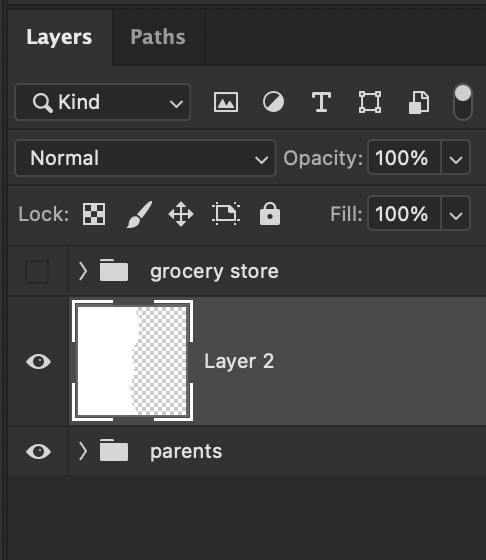
3) Masking the top gif
Use the command (or ctrl) key and click on the thumbnail in the layers panel for your ripped paper layer (the square highlighted in white in that last screenshot). You should get a marching ants selection around the ripped paper like so:

Now reveal your top gif group (by clicking on the eye icon), and make sure you have the group selected in the layers panel. You should still see the selection around where your ripped paper is, like so:

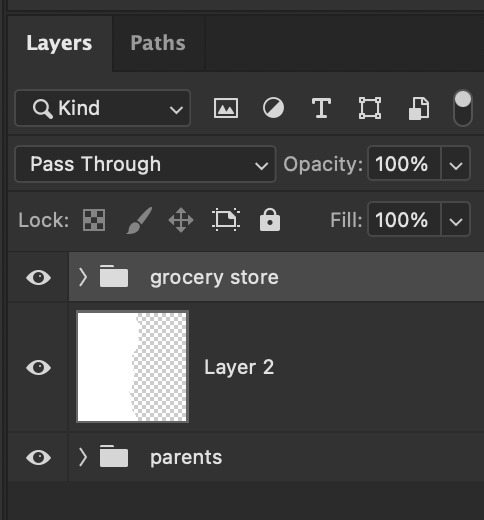
Now go to the bottom of your layers panel and click on the little mask icon:

And now you should get a mask on your top group in the shape of the ripped paper, and you should be able to see both gifs simultaneously on the canvas:


If the black and white areas on your layer mask are flipped after you click on the mask icon, just click on the layer mask and use the command + i (ctrl + i) keys to switch it back so that you can see both your gifs.
4) Final touches
Now if you're happy with the result so far, you can absolutely stop here. However, I wanted to show the uneven rip (like how when you rip a piece of paper you can see some white bits on the edges).
To do this, select your move tool (shortcut: click the v key on your keyboard) and making sure your ripped paper layer (NOT the mask) is selected, use your arrow keys to move it slightly until it shows between the two gifs.


It currently looks a little too clean for my liking, so I like to move it slightly up/down as well so that it looks more uneven and natural. If your overlay is too small, just use the transform function (command + t or ctrl + t) to resize it so that it fills the canvas. This is what mine looks like after I mess around with it:

And you're done! If you want to adjust any colouring, just go into the gif group and you can edit the layers from there.
Hope this helps anon! Let me know if you have any questions!
#answered#Anonymous#*tutorial#alielook#usernik#userdean#usersalty#userriel#userraffa#usershreyu#userbess#userrobin#usercats#tuserheidi#userkimchi#userelio#usershale#usercharisse
293 notes
·
View notes
Text
D2 Divisional Chart: Hora Chart
The D2 divisional chart, also known as the Hora chart, is a Vedic astrology tool used to analyze wealth and financial prosperity. This chart is derived by dividing each sign of the zodiac into two equal parts, each ruled by either the Sun or the Moon.
1. Sun and Moon Hora Rulership
The D2 chart is divided into two horas per sign. The first 15 degrees of any sign are ruled by the Sun (Solar Hora), and the second 15 degrees are ruled by the Moon (Lunar Hora). This division reflects the balance of masculine and feminine energies in relation to wealth and prosperity.
2. Wealth and Prosperity Indicators
The placement of planets in the D2 chart provides insight into your financial status and how you attract wealth. Planets in Solar Horas indicate active, assertive means of acquiring wealth, while those in Lunar Horas suggest a more receptive and nurturing approach.
3. Analyzing the Chart
Ascendant and Ascendant Lord: The sign and its lord in the D2 chart's ascendant indicate the primary approach to wealth and financial matters. Planets in Solar Hora: These planets show areas where you might actively seek and earn wealth through initiative, hard work, and leadership. Planets in Lunar Hora: These planets reflect areas where wealth may come through passive means, inheritance, nurturing, and emotional intelligence.
4. Key Planets to Consider
Sun and Moon: The natural rulers of the D2 chart, their positions can reveal the strength and balance of financial energies. Jupiter: The planet of wealth and abundance, its placement can indicate where opportunities for financial growth lie. Venus: Associated with luxury and material comfort, Venus’s position can show areas of potential indulgence and financial gain.
5. Wealth-Building Strategies
By understanding the D2 chart, you can tailor your financial strategies. For example, strong Solar Hora placements might suggest taking bold, entrepreneurial actions, while strong Lunar Hora placements might indicate benefiting from investments, savings, and nurturing existing resources.
6. Practical Applications
Use the D2 chart to guide financial decisions, investments, and career choices. By aligning your actions with the insights from the Hora chart, you can enhance your ability to attract and manage wealth effectively.
7. Balancing Energies
The D2 chart emphasizes the importance of balancing active and passive financial strategies. Embrace both the assertive, action-oriented Solar energy and the receptive, nurturing Lunar energy to create a holistic approach to wealth.
Understanding the D2 Hora chart provides a nuanced view of your financial potential and helps you harness both the active and passive aspects of wealth-building in your life.
©️kleopatra45
#astrology#astroblr#astro notes#astrology readings#astrology tumblr#astrology observations#astrology community#astro community#vedic astrology observations#vedic astrology#vedic astro notes#vedic astro observations#vedicastrology#vedic chart#divisional charts#d2 chart
54 notes
·
View notes
Text
Venus in the 5th house

✨Venus in the 5th house: Embracing the Romance and Creativity of Life✨
Venus in the 5th house is like a brush dipped in stardust, painting your life with romance, creativity and an eye for all things beautiful. This placement transforms you into a beacon of charm and artistic flair, drawing love and joy into your orbit. It’s not just about the art you create but the artful way you live your life.
Creativity flows through you effortlessly. Whether you’re drawn to painting, music, dance, or drama, your artistic expressions are infused with a unique, magnetic energy. But it’s more than just traditional art forms—you have a gift for turning everyday experiences into something extraordinary. Your creative spirit isn’t confined; it spills over into your approach to problem-solving and your ability to make life itself a work of art.
Romance with Venus in the 5th house is a series of passionate chapters filled with grand gestures and intimate moments. You’re a true romantic, seeing love not just as a part of life but as a vital, enriching experience. Your charm and magnetism make you irresistible, drawing admirers like moths to a flame. You revel in the highs of love, and even the lows become poetic in your eyes.
Life’s pleasures are your playground. You approach social gatherings with a sense of fun and playfulness that’s infectious. You’re often the heart of the party, your laughter and zest lighting up the room. Your positive energy not only uplifts you but also those around you, making every social interaction a memorable celebration.
Children hold a special place in your heart. Whether you’re a parent, an aunt, or simply someone who loves the innocence and creativity of kids, you connect with them effortlessly. Raising children or engaging with them brings out your best qualities, filling your life with joy and fulfillment.
Yet, this placement isn’t without its shadows. Venus in the 5th house can lead to overindulgence. You might find yourself chasing pleasures to excess, whether it’s spending too much on entertainment, indulging in romantic escapades, or savoring one too many decadent treats. Balance is crucial to avoid the pitfalls of excess.
Your romantic idealism can sometimes lead to heartache. You might idealize your partners, crafting perfect fantasies that reality struggles to meet. When reality falls short, disappointment can hit hard. It’s essential to remember that real love involves effort, compromise, and finding beauty in imperfections. Attention-seeking can also be a challenge. You thrive in the spotlight and might feel unfulfilled without it. This need for recognition can strain relationships if not kept in check. Staying grounded and valuing mutual respect and understanding is key.
The fun loving nature of Venus in the 5th house can also lead to risky behavior. Whether it’s gambling, impulsive decisions, or diving into whirlwind romances, your desire for excitement can sometimes cloud your judgment.
There are subtle nuances to this placement that often get overlooked. The creativity you possess isn’t just about making beautiful things; it’s a powerful tool for healing. Artistic pursuits can help you process emotions, heal old wounds, and create a harmonious inner world. Engaging in these activities is like therapy for your soul, providing solace and clarity.
In our fast-paced, achievement-oriented world, the importance of play is often underestimated. Venus in the 5th house reminds you that playfulness and joy are essential for a balanced, happy life. Embracing play through hobbies, sports, or simply enjoying time with friends can rejuvenate your spirit and bring deeper fulfillment. This placement also blesses you with deep empathy and an ability to connect emotionally with others. You have a knack for making people feel seen, appreciated, and loved. This talent can be a powerful asset in both personal and professional relationships, fostering genuine connections and mutual understanding.
Venus in the 5th house is a gift, filling your life with joy, creativity, and love. By acknowledging and balancing the challenges, such as overindulgence and romantic idealism, you can harness its full potential.
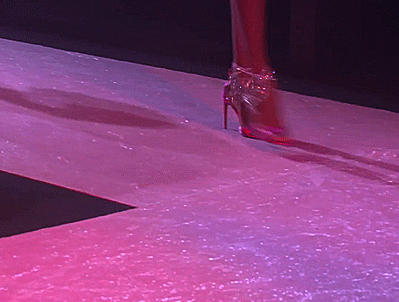
#astrology#astro notes#astro observations#zodiac#astrology community#astro placements#venus#venus 5th house#5th house venus#leo venus
106 notes
·
View notes
Text
Ok last post about this but here's some simple points that it's imperative you read and understand if you genuinely care about trans people especially as one yourself;
A) No sex or gender is virtuous or sinful by default. It's a persons words and actions which determine what kind of person they are. Leave this 'innate sin' Catholic bs at the door and send the pedestal you're forcing trans fems to sit on out with it.
B) Therefore any trans person can be transphobic, transmisogynistic or transandrophobic including if they're amongst the group targeted by the intersectional terms. All of these types of bigotry are unacceptable, regardless of your personal perceived impact on yourself and others. Nobody should be subject to any kind of bigotry.
C) This does not mean ALL members of X group are Y kind of bigots but it also doesn't mean that no X group members are Y kind of bigots. It's good to be careful of these lines of thinking in anyone if we want to get rid of it but see point A.
D) Holding individuals accountable and opposing the general ideology of transmisogyny, transandrophobia and general transphobia (including nonbinaryphobia/exorsexism and transmedicalism) is more affective than demonising a whole group based on their identity. If members are radicalised or bigoted already, they're not changing their minds because you yelled at them to kill themselves nor are they unworthy of redemption.
E) Listening to people directly about the bigotry they face is the key to understanding bigotry you might not face yourself.
F) Trans unity is the tool we need to craft a fortress so strong we can weather any storm but it won't work if we believe that's enemies in our own lines.
G) Using female-orientated insults towards trans mascs is still misogynistic. Using male-orientated insults towards trans women is still transmisogynistic. Telling anyone to kill themselves for existing loudly and in a way you disapprove of, puts you in the wrong automatically. Telling someone or a whole group to kill themselves also invalidates anything else you wish to say before or after said statement.
H) Failure to understand any of this means you are helping no groups, or even yourself, instead you are likely contributing to trans harm. Including harm to the groups you are most personally invested in helping.
Equality doesn't mean making the oppressed the oppressors and it sure as hell doesn't mean the oppressed oppressing each other. Stop doing the TERFs jobs for them.
95 notes
·
View notes
Note
Hi!
From someone who is disorganized and discouraged, I would love advice on weight-lifting/building muscle. Would you share your understanding of building muscle and the breakdown of diet?
If possible, could you share how you apply what you know to yourself? If you use any tools to help you?
Struggled with working out, gaining weight, and eating my whole life. Thanks!
prefacing this with some important info for fellow disorganized scatterbrains!!!!
the main reason why ppl have trouble sticking to a lifestyle change is because they try to make very drastic changes too quick, and you get overwhelmed and it becomes unsustainable. this is especially an issue for neurodivergent folks, and since it's Tumblr I assume a good chunk of y'all are (me too dw)
DON'T immediately overhaul ur diet and hit the gym 5x a week from day 1!!! hitting tiny goals consistently is also more rewarding than working towards one very large arbitrary goal that you might not reach, esp when it comes to working out. start veeery small if u need to, such as only 10 bodyweight squats per day like i did and go from there. you wanna program ur brain into feeling accomplished to keep you motivated. patience is key!!!!
ok!! now onto the more detailed info below
Disclaimer: I'm still a newbie myself!! only consistently lifting heavy for about 3 months as of this post. I did a good deal of excessive info diving on lifting using the power of Sheer Autism, and my main gym buddy is very experienced & taught me a good chunk of this shit so shout-out to my pal for making all this possible xoxo
so good news!! "building muscle" is very easy for beginners starting from zero. newbie gainz are absolutely real. at this stage you can do just about anything at the gym and get stronger bc u can only go up. BUT!! if you structure it, you can make the process enjoyable and much more efficient. if you're goal oriented (lookin at u ADHD menaces), you'll love the concept progressive overload.
PROGRESSIVE OVERLOAD & SETS/REPS
wikipedia defines progressive overload as: a method of strength training and hypertrophy training that advocates for the gradual increase of the stress placed upon the musculoskeletal and nervous system. in layman's terms, it just means gradually adding more weight as you work out to increase the difficulty as you get stronger. progress is VERY easy to track because of this, and you'll be hitting PRs pretty much every week for the first couple of months and that shit feels fantastic because you physically feel yourself getting stronger so rapidly. I use the app Strong to track my workouts. so, how do we structure progressive overload? that's through sets/reps. A rep is a single execution of an exercise. 1 squat is one rep. 2 squat is 2 reps. and so on. A set is a collection of reps. The format is Sets x Reps, for example: 3x5 means 3 sets of 5 reps. You will rest between sets, and it's typically anywhere from 1 minute all the way up to 5 minutes depending on the level of exertion/type of training you are doing. Heavier weights mean longer rest periods and vice versa.
WHERE DO I EVEN START??
For those interested in barbell training: the r/fitness beginner routine is pretty good! I also recommend 5x5 stronglifts. both are very straightforward, but also note the typical olympic barbell is 45lbs. If this is a weight you struggle with, you can begin with bodyweight exercises, dumbbells, or machines at the gym which are all very BEGINNER beginner friendly. especially when it comes to legs you're probably much stronger than you think. Most people can squat 45lbs first try. don't be afraid -- you're standing on those things all day, they can support hella weight. Like I mentioned earlier, don't be afraid to start veeeery small and work your way up from there. I started at home with doing only bodyweight squats without the barbell, then added on benching with light 7lb dumbbells after a week, then impulse signed up for a gym membership a month later and began to go there to use equipment and now i'm deadlifting over 100lbs as a tiny girl that previously was too weak to even lift a 40lb dog. it snowballs quicker than you think once you gain confidence in your own body and its abilities!
WOAH I DON'T KNOW HOW TO SQUAT/DEADLIFT/BENCH/THIS IS SCARY AND IM FUCKING UP
If you can, i highly recommend getting a personal trainer to assist you, or tag along with a gymrat pal to show you the ropes. This page is also a good resource to learn specific lifts. otherwise, youtube is your best friend. you can record your sets and compare your form to form tutorials on youtube, and actively take notes on what to change the next time you work out. Be an active learner!!! be aware of what muscles are engaged when you lift and how your body feels. almost NOBODY gets it right the first time, esp with barbells. we've all made fools out of ourselves at the gym as beginners it's chill. i find people at the gym are very nice and willing to help you out if you're struggling, and people don't judge at all-- it's very easy to get in your own head in these spaces but most humans there are supportive and want you to succeed, especially since it's a hobby they are also passionate about. the more you do it, the less anxious you get. exposure therapy is very effective!! Also, almost all the barbell exercises can be replaced with smaller dumbbells, and you can do them at home if you get your own set + a workout bench (pretty cheap if u get secondhand, check facebook marketplace/craigslist). i got mad social anxiety myself so i understand sometimes you just can't, and this is an option for those that find public spaces overwhelming.
DIET
I personally don't think specialized diets/precise macro tracking is super duper important for newbies/casuals, only moderately important (spicy take for some but whatever). but you probably naturally will take an interest in diet once you realize it'll help you perform significantly better in the gym. the only macro i track is protein. You can use a TDEE (total daily energy expenditure) calculator to roughly estimate the amount of protein you need for maximum gainz. it's usually around .7-1g of protein for every pound of lean body mass (weight that isn't fat mass). Imma be real it's pretty hard for me to hit the recommended protein goal and most days I don't because my appetite just can't kick in for the amount it demands, and protein is super filling. I found that if i decreased the amount of carbs i eat, i am able to consume more protein bc i guess there's more room in my stomach lol. i eat a fuck ton of greek yogurt, chicken, fish, and tofu. when i started working out, i begin cooking a lot more and found i naturally craved less processed junk foods and snacks because the protein was keeping me full all day which is a plus! Even when im not regularly hitting my protein goal my gym progress is still going well and I think it's simply because my diet is A LOT better than what it used to be in my gremlin days. I also eat a lot more now that i've gained a bit of muscle, so do be prepared for food costs to go up as your metabolism increases and demands more energy to upkeep your gainz.
HOW LONG DOES IT TAKE FOR ME TO LOOK LIKE A MUSCLE MOMMY????
a whileeee. over a year, probably, unless if you're on anabolic steroids (dont ever do that u will quite literally die). and physique is mostly from diet since it's dependent on your body fat percentage, the saying "abs are made in the kitchen" is true. its why you see hyper skinny terminally indoors gamer dudes with abs, even if they'd snap in half if you farted in their general direction. those mfs barely eat they too busy being gamers i am no longer interested in lifting for aesthetics personally since i get more joy from hitting PRs and i'm pretty content with my body image, but ik physique is the reason why most people get into lifting so i'll touch on it. Weightlifting on its own will not make you lose weight or fat. Again, it needs to be supplemented with a healthy sustainable diet (DO NOT DO CRASH DIETS THAT SHIT IS GARBAGE) and a form of cardio. I actually gained 8lbs since I began lifting from water retention & new muscle mass (muscle is more dense than fat, your body retains water when repairing muscle after a gym sesh) but my measurements and pants size have remained the same. I'm short, so something as small as a 5lb increase usually bumped me up a pants size but it didn't this time bc im gettin swole :') if you want to track physique changes, measuring your waistline & progress pics is a better way to do so than the scale. If you want bigger muscles, look into hypertrophy training. it's a tad different from strength training, mainly because you do higher reps at a lower weight.
384 notes
·
View notes
Text
Fadal Tool Changer - Overview
About Fadal Tool Changer Parts When it comes to Fadal tool changer parts, quality and reliability are paramount. At ITSCNC, we understand the importance of keeping your CNC machines operating at peak performance, which is why we offer a comprehensive selection of tool changer parts backed by a 90-day warranty. Whether you need carousel arms, grippers, or other components, we have you…

View On WordPress
#CNC Tool Changer Parts#Fadal Arbor Shim#Fadal Arm Roller Assembly#Fadal ATC Roller Assembly#Fadal ATC Slide Motor#Fadal ATC Tool Changer#Fadal BT Tool Clip#Fadal CAT40 Tool Clip#Fadal CNC Machines#Fadal cnc parts#Fadal Dual Arm Tool Changer#fadal machine parts#Fadal parts#Fadal Parts For CNC Machine#fadal parts online#Fadal Reman Servo Turret Amplifier#Fadal Roller Bearing#Fadal Servo Turret Power Supply#fadal tool changer#Fadal Tool Orientation Key#Fadal Turret Carrier#Fadal Turret Spindle#Fadal Turret Worm Gear
3 notes
·
View notes
Note
After approx. 2-3 months of studying Japanese I started to read free graded readers online and then graduated to a collection of short stories that I purchased off of Amazon. I thought that the reason I was starting to have trouble understanding sentences was because I didn't know enough vocabulary but it was because I neglected grammar completely. It was sorta drilled into my head off of Youtube creators to just study kanji, vocab and simple sentences as much as possible before even touching grammar. I feel absolutely lost, dude. I am at the 5 month mark now. I can "breeze through" kanji for the most part. (as in, I can actually retain it in a decent amount of time) I decided to study grammar about a week ago. It is SO FREAKING HARD. I don't know if there's something wrong with me or what. I don't know if it's supposed to feel like what I thought I knew is being ripped apart at the seams, stapled together, and then torn apart again....but it does.
Do you have any tips for learning grammar? Is this feeling normal? Can you tell me when the pressure in my skull will subside? I am using Bunpro's free trial but I'm unsure if this tool will actually help me. I write tons of notes to flip through but I still fail to give them the nuanced answer they're looking for. I really enjoy the setup of Bunpro and I want to like it since it's similar to WK but I'm not sure if I'm going too fast or there's a better way to learn. I stopped learning 5 new grammar points a day and started doing only 2. (I also have Genki I and watch GameGengo. He explains things in a way that's easy for my brain to understand.) Sorry for the long post but any insight would be appreciated. I'm a bit nervous asking people in the language learning community for help or insight because a lot of them treat it as a way to show how fast they learned/1-up others. Tumblr's langlearn community is a lot different with what I've seen (or maybe I'm just following the right ppl lol)
Hi! Thank you so much for waiting for this response--I'm sorry it took so long. Your message was one of the ones that popped up when they locked my ask box (they actually still haven't answered me on why it was locked so 🤷♀️). To make up for that, I'm gonna be longwinded because I think that this is a super valid and important question that others may also want to know the answer to!!
Pls pls PLEASE DM me if none of this is helpful or if you'd like to talk more about what you think you need help with!!
I think that sometimes when we're learning a new language that we know is so overwhelmingly different from our own language, we focus on the things that we think will be the main hinderance and sometimes we forget the key points. You might be thinking "how did I forget grammar?" but I would say don't beat yourself up about it! Many of us focus on the things that we think are our problems(--the last time I studied for the JLPT, I focused on my weak point too much and then was frustrated with myself during the exam bc I neglected the other areas.)
I don't want to lie to you and say that learning grammar will is going to get easier because that's not the case for everyone. Think of learning grammar vs everything else as learning different types of math or science--have you ever had a friend that was absolutely phenomenal at algebra or calculus but couldn't do geometry? Or a friend that was wonderful lab partner in chemistry but struggled in biology? They're struggling in biology because it requires a ton of rote memorization in comparison to practical application and math that's present in chemistry and rote memorization may not necessarily be their strong point. Personally, I think that's also why a lot of us struggle with certain grammar points. There are some that just click with us immediately and then there are others that we have to see over and over and over and over and over--you get the point--just for us to find a single sentence with it that we understand. If you're math oriented, we need to figure out a way to no longer make grammar points rote memorization for you, but to turn it into a formula of some sort. I actually write my notes out in ways that are like that--I use plus signs (+) in my notes not because the textbooks use them but because my brain genuinely reads it as "noun + particle + grammar point = a sentence that makes sense" because, for me, formulas don't fail. Your weak point doesn't have to be your weakness--you can turn the weakness into a strength that works just for you.
I've been going at this for years and every single professor or Japanese friend (or even people from the discord server) I have can tell you that I've struggled with pretty much any grammar point that included ~ように--and it wasn't because I wasn't trying, but because I couldn't find myself using any sentences that with those grammar points because I found the alternatives/similar ones to make more sense. Surprisingly, it wasn't until I was reading 夜カフェ for our book club that I was actually able to start grasping the meaning (ngl, I still haven't used it myself--I'm notorious for using alternatives); I was finally witnessing it being used in a way that made sense in my brain.
The frustration you're feeling when you encounter a new grammar point or overload yourself with too many things in one go is completely normal and I promise that a ton of us in the Japanese langblr community have definitely experienced it too! It probably feels like everything you know is being ripped apart because your native language may have a SVO (subject-verb-object) format while Japanese has a SOV (subject-object-verb) format--your 1-to-1 translations for your notes may not be helpful in the beginning because you're still trying to wrap your brain around the fact that your words still need to go in another order than you're used to. And then you add the new grammar points and concepts on top of that (like particles and other things) and it can become overwhelming and frustrating. Sometimes, you're going to find some grammar points just downright annoying--especially when you find that there's no equivalency to it in your own language. But don't give up!
I know this is a super cliché thing to say, but practicing them will help. If you can, I would make note of the grammar points that you're struggling with, try to make sentences with them, and ask somebody to check them and explain exactly why (or why not) they're working and then ask them for examples because they may have an even better way of explaining it to you than what you've come up with for yourself!
I can look back at old notes and see when I wrote a sentence as an example just because a textbook/professor used it but I didn't actually understand why it worked at the time and then I can also find notes where the sentences written as examples were added once I finally found something that clicked for me.
You've already done yourself a favor by learning a lot of vocab, kana, and kanji because now you'll be able to try out an array of ways to pick up grammar instead of just a textbook. (I will make a note that if you're looking to take the JLPT, I would recommend having a list of grammar points that you would need to know for the level that you're planning on sitting for because there's no guarantee of what will or won't pop up on the test.)
Another important thing while you're practicing: be comfortable with making mistakes. We all make them, but when you're learning a new language it's important to be ready to make mistakes and to welcome them with open arms because it gives you a chance to experience and learn in real time.
ALSO: for you specifically--because you're interested in reading, you might enjoy learning grammar through tracking the different grammar points through what you're reading and using the sentences as your examples because they're all going to be cohesive. And if reading books or other things totally turn you off right now, maybe games? Animal Crossing and Pokemon are very nice games to play in Japanese for people that are just starting out! You may also enjoy using Lingo Legend--it's an JRPG language learning app that I beta tested and I think that it's a nice way to review (it has some fun incentives). I'm not a big gamer, so I struggle with learning through games, but I've been picking up a lot of grammar through reading because I focus on finding things that I'm interested in, rather than things that are "at my level." When I start a manga, I will scour a ton of websites and forums and bug a ton of people when I come across a grammar point that I can't wrap my brain around because I want to be able to understand what's going on.
We have book clubs and gamers in my discord server, as well as places for people to post what they're practicing or to ask for help. We have people of all varying levels and different skillsets that love to share their wisdom with others.
I haven't used Bunpro, but I know that @sammilearns has, so she may be able to weigh in on that! And @tokidokitokyo @nihongoseito @chouhatsumimi @kanpeki-bekki @burgeoning-ambition probably also have even more tips that me--I'm trying to tag people that I know we all learn in different ways, so their tips and tricks might be just what you need!
Please weigh in, fellow langblr members! How have you been learning grammar? Are you game-ifying it? Have you turned it into math equations? Have you managed to tie it in with your special interest? I can't wait to see what people add to this post!
#wow...i talk too much#asks#onigiri asks#onigiri answers#onigiri replies#japanese#resources#grammar#japanese grammar#study resources#reading resources#mine#langblr
45 notes
·
View notes
Text


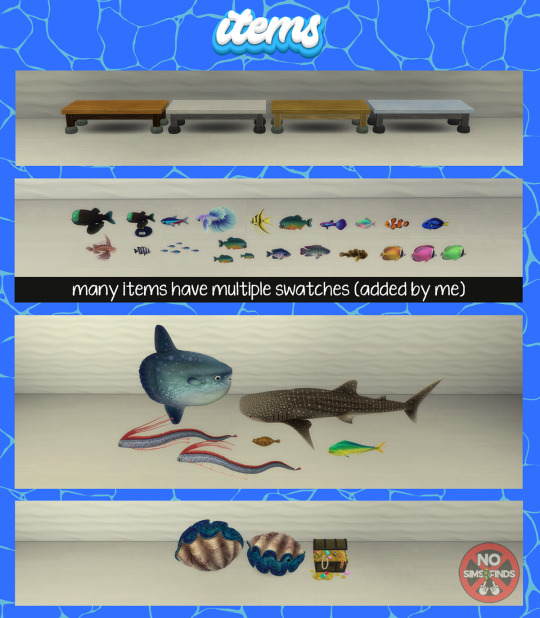


🫧 🐟 ACNH Aquarium Set 2 🐟 🫧
Sims 4, Base game compatible. 30 items - I have added extra swatches to many of the items 🌺
Set contains: -Angelfish | 3 swatches each | 294 poly -Barreleye Fish | 2 swatches | 912 poly -Barreleye Fish Display | 2 swatches | 1046 poly -Bench (functional) | 4 swatches | 664 poly -Beta Fish | 9 swatches | 524 poly -Bitterling | 3 swatches | 358 poly -Bluegill | 1 swatch | 640 poly -Blue Tang | 7 swatch | 700 poly -Clownfish | 3 swatch | 396 poly -Dark Sleeper | 1 swatch | 636 poly -Giant Clam 1 | 5 swatches | 1498 poly -Giant Clam 2 | 5 swatches | 1498 poly -Guppy | 7 swatches | 468 poly -Humphead Wrasse | 1 swatch | 1000 poly -Japanese Flounder | 4 swatches | 474 poly -Luna Lionfish | 1 swatch | 856 poly -Mahi Mahi | 1 swatch | 1008 poly -Neon Tetra | 4 swatches | 298 poly -Neon Tetra Group | 4 swatches | 1778 poly -Oarfish 1 | 5 swatches | 2002 poly -Oarfish 2 | 5 swatches | 2002 poly -Ocean Sunfish | 4 swatches | 1602 poly -Oriental Butterfly Fish | 9 swatches each | 474 poly -Pale Chub | 6 swatches | 294 poly -Piranha | 1 swatch | 602 poly -Piranha Group | 1 swatch | 1802 poly -Striped Beakfish | 1 swatch | 700 poly -Tilapia | 4 swatches | 702 poly -Treasure Chest | 2 swatches | 2401 poly -Whale Shark | 1 swatch | 1978 poly
Type “animal crossing aquarium2” (no space between aquarium and 2) into the search query in build mode to find quickly. You can always find items like this, just begin typing the title and it will appear.
📁 Download (SFS, No Ads): HERE
📁 Alt Download (still no ads): HERE
🐙 Aquarium Set 1 is HERE 🦑
Always suggested: bb.objects ON, it makes placing items much easier. For further placement tweaking, check out the TOOL mod.
Use the scale up & down feature on your keyboard to make the items larger or smaller to your liking. If you have a non-US keyboard, it may be different keys depending on which alphabet it uses.
As always, please let me know if you have any issues! Happy Simming!
✨ If you like my work, please consider supporting me
★ Patreon 🎉 ❤️ |★ Ko-Fi ☕️ ❤️ ★ Instagram📷
Thank you for reblogging ❤️ ❤️ ❤️
@sssvitlanz @maxismatchccworld @mmoutfitters @coffee-cc-finds @itsjessicaccfinds @gamommypeach @stargazer-sims-finds @khelga68 @suricringe @vaporwavesims @mystictrance15 @public-ccfinds
The rest of my CC
#s4cc#ts4cc#sims 4 aquarium#sims 4 fish#sims 4 animal crossing#sims 4 tropical#sims 4 maxis match#sims 4 object#simdertalia
261 notes
·
View notes
Text

Introducing the Makarov - The Mech Scaling Scout
The second in the “TechSteel” line of frames created, The Makarov is a lightweight frame, dedicated to support via scouting, ambush and disruption of hostile targets. The base frame is an over modified Locksteel heavy hardsuit, stripped down then rebuilt with a range of gripped fingers and boots, auxiliary hooks and a range of other features to assist with navigating onto opposing frames, with the specific goal set in mind to make that single target’s life a living hell while allies do the brunt of the damage.
When unable to move onto a target, or when it is simply unsafe to do so, the Makarov can be equipped with a range of utility to support allies from behind friendly lines, primarily oriented around softening targets and hardening allied systems.
-
When it comes to utility over raw firepower, the Makarov is king, The key feature of Locksteel’s smallest mech is that of its ability to climb onto and Jockey targets as if it were any pilot but, with the strength of a mech-scale reactor behind those arms. While latched onto an unfortunate foe, the Makarov stunts their firewalls, tears off their plating and all in all ruins any good pilot’s day.
It’s license brings with it a range of tools more appropriate for a commander than a sole fighter. Its “Chain of Command” and “Reactive Fortification” Systems make sure no ally is out of your sensor range and unprepared and Signal Flares and System Scrubbing put enemies out in the open for your scarier teammates to tear them apart.
198 notes
·
View notes
Text

Each of us may feel a natural pull toward certain elements, and this connection often guides our practice. When you resonate strongly with an element, it can shape the tools you gravitate toward, the spells or rituals you prefer, and even the types of energy you seek to harness. For example, I feel a strong connection to Earth, which makes me more drawn to working with plants, stones, and natural items. I collect them, study their properties, and use them more frequently in my practice than divination tools, oils, or other magical items.
Those connected to Earth often feel drawn to plants, herbs, crystals, and other materials from nature. They may focus on grounding rituals, protective spells, and practical magic. Earthy individuals might enjoy crafting, creating physical talismans, and cultivating spaces of peace and stability. The sensory experience of touch can be powerful, and the connection to growth, endurance, and healing feels deeply meaningful.
Those drawn to Water may find themselves called to emotional healing, dream work, and intuitive practices. They may feel a natural inclination toward using cups, bowls, or other vessels in rituals, as well as focusing on purification and fluidity. Water-affinity can lead to using oils, creating spell baths, or crafting potions. Many Water-oriented practitioners find the realm of feelings and intuition a key component of their work.
Those connected to Fire are drawn to transformative magic, courage, and passion. They might enjoy working with candles, incense, or sigils that involve burning, as well as channeling energy into fast, powerful spells. Fire can be intimidating; it’s unpredictable and demands respect. But Fire is also a teacher, showing how to harness strength and will with balance and control.
People drawn to Air often find meaning in ideas, symbols, and the realm of thought. They may work heavily with spoken or written spells, divination tools like tarot or runes, and enjoy working in open spaces. Air brings clarity and movement, perfect for spells that involve insight, knowledge, and communication. Many Air-oriented practitioners feel empowered through visualization and meditation, connecting deeply with the mind and spirit.
Spirit (or Ether): Those resonating with Spirit often feel connected to a sense of unity and intuition that goes beyond the physical. They may be interested in connecting with ancestors, exploring astral work, or developing their inner vision. Spirit is the element that unites the other four, bringing balance and harmony, and often calls for practices that embrace the unseen or the mystical.
And while we may feel comfortable with certain elements, there are often others that feel mysterious, intimidating, or even unpredictable. I still feel uneasy around fire—the first time I made incense, I ended up with ashes and half-burned ingredients everywhere. These elements might represent areas of growth in our practice. By gradually working with these, we can expand our understanding and find new strengths.
Each person’s connection to the elements is unique. Some may feel strongly drawn to one element, while others resonate with a combination, all of them, or even none at all in the traditional sense. This variation reflects our individual ways of perceiving and interacting with the world. Each path is valid and personal, shaped by how we experience and understand these forces.
For instance, someone might feel equally drawn to both Earth and Water, finding a balance between grounding energies and emotional depth in their practice. Another may feel an affinity with all elements, seeing them as interconnected aspects of nature and life itself. Others may not feel a direct pull toward any single element but instead feel a connection to a universal energy beyond the traditional categories.
Honoring your own alignment with the elements—or lack thereof—is a core part of developing a practice that feels authentic. Whether we see ourselves in a single element, a mix, or beyond them all, these connections guide us, influencing how we interact with energy, the tools we choose, and the type of magic we are called to explore.
#elements#reflection#book of shadows#grimoire#spellcraft#paganism#witchblr#witchcraft#wicca#witches#beginner witch
17 notes
·
View notes
Text

There are other reasons why environmentalism might have looked like a bourgeois playground to Said. The Israeli state has long coated its nation-building project in a green veneer – it was a key part of the Zionist ‘back to the land’ pioneer ethos. And in this context trees, specifically, have been among the most potent weapons of land grabbing and occupation. It’s not only the countless olive and pistachio trees that have been uprooted to make way for settlements and Israeli-only roads. It’s also the sprawling pine and eucalyptus forests that have been planted over those orchards, as well as over Palestinian villages, most notoriously by the Jewish National Fund, which, under its slogan ‘Turning the Desert Green’, boasts of having planted 250 million trees in Israel since 1901, many of them non-native to the region. In publicity materials, the JNF bills itself as just another green NGO, concerned with forest and water management, parks and recreation. It also happens to be the largest private landowner in the state of Israel, and despite a number of complicated legal challenges, it still refuses to lease or sell land to non-Jews.
...
The JNF is an extreme and recent example of what some call ‘green colonialism’. But the phenomenon is hardly new, nor is it unique to Israel. There is a long and painful history in the Americas of beautiful pieces of wilderness being turned into conservation parks – and then that designation being used to prevent Indigenous people from accessing their ancestral territories to hunt and fish, or simply to live. It has happened again and again. A contemporary version of this phenomenon is the carbon offset. Indigenous people from Brazil to Uganda are finding that some of the most aggressive land grabbing is being done by conservation organisations. A forest is suddenly rebranded a carbon offset and is put off-limits to its traditional inhabitants. As a result, the carbon offset market has created a whole new class of ‘green’ human rights abuses, with farmers and Indigenous people being physically attacked by park rangers or private security when they try to access these lands. Said’s comment about tree-huggers should be seen in this context.
...
But this only scratches the surface of what we can learn from reading Said in a warming world. He was, of course, a giant in the study of ‘othering’ – what is described in Orientalism as ‘disregarding, essentialising, denuding the humanity of another culture, people or geographical region’. And once the other has been firmly established, the ground is softened for any transgression: violent expulsion, land theft, occupation, invasion. Because the whole point of othering is that the other doesn’t have the same rights, the same humanity, as those making the distinction. What does this have to do with climate change? Perhaps everything.
We have dangerously warmed our world already, and our governments still refuse to take the actions necessary to halt the trend. There was a time when many had the right to claim ignorance. But for the past three decades, since the Intergovernmental Panel on Climate Change was created and climate negotiations began, this refusal to lower emissions has been accompanied with full awareness of the dangers. And this kind of recklessness would have been functionally impossible without institutional racism, even if only latent. It would have been impossible without Orientalism, without all the potent tools on offer that allow the powerful to discount the lives of the less powerful. These tools – of ranking the relative value of humans – are what allow the writing off of entire nations and ancient cultures. And they are what allowed for the digging up of all that carbon to begin with.
2 June 2016
#naomi klein#edward said#climate change#palestine#israel#london review of books#environmentalism#conservation#jewish national fund#jnf
80 notes
·
View notes